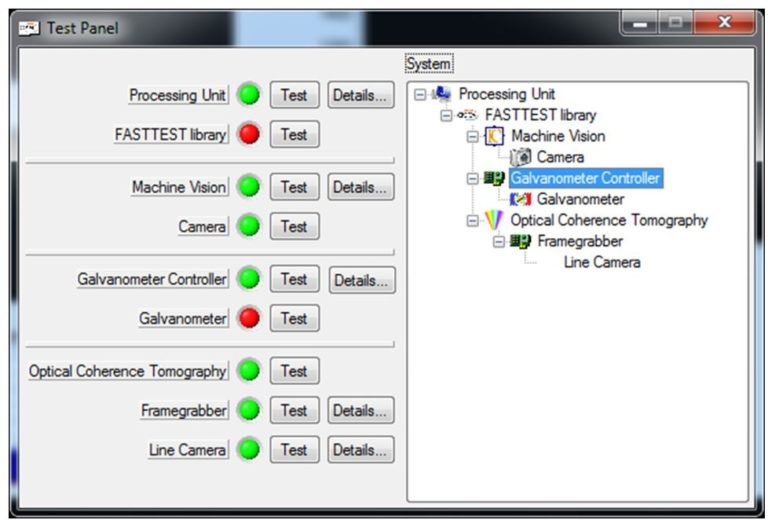FASTTEST is an R&D project developed internally by ASENSE to research and develop a non-destructive 3D inspection system for microfluidics and microdevices. The idea arose after our participation in the Seventh Framework Programme of the European Community (7PM) – FaBiMed, in which we were leaders of the “Quality Control and Inspection” work package.
What’s faster? Does the fastest system do it?

The FASTTEST system performs a quantitative mechanical quality assessment of micromachined parts on assembly lines, evaluating the quality of the manufacturing process (conformity to mechanical specifications). The parts evaluated with FASTTEST have dimensions of a few mm in x-y and only a few mm in depth. The measurement accuracy is on the order of a few µm.
The following figure presents the schematic of the FASTTEST system as seen from the software architecture. The hardware components of the system are represented in gray; the code sections are in blue; and the communication channels and data buffers are in red.
The interpreter stages in the GUI are used to translate commands and data to/from the assembly line, external data files, the GUI itself, and the functional core.
The start of the project
Since the beginning of the FASTTEST development project, work has focused on software integration and optimization of the various assemblies that make up the FASTTEST instrument. The OCT measurement and the FFT leading to depth measurements have been performed and calibrated. The OCT data acquisition rate is now hardware-limited to 40,000 depth profiles per second. A user interface now allows the user to select the path the OCT should scan.
The system can self-configure and perform measurement operations following an inspection route entered by the user. Computer vision is capable of recognising patterns that will be used to automatically guide the OCT beam to regions of interest. FASTTEST has been demonstrated to potential customers, and discussions are currently underway with a medical device manufacturer regarding the application of the system’s capabilities to a particular quality control problem that they have been unable to resolve previously. The adaptation of the software by AI to the specific needs of potential customers has increased the customer base for the FASTTEST system.


In the image above, we can see a 3D map of a syringe needle portion. The inspection area was selected using software, which reconstructed the depth map in false colors (each color corresponds to a depth value, according to the color scale displayed on the right side of the image). Through FASTTEST, customers can program the relevant inspection route to assess the quality of their manufactured parts, saving time and improving their reliability.
FASTTEST is a fully autonomous system and, as such, features a comprehensive set of automated diagnostic tools for reliable hardware monitoring.
Since the beginning of the project, ASENSE has achieved significant improvements to the FASTTEST instrument, placing it beyond the current SoTA for non-contact micrometer inspection technology. The measurement rates achieved in 3D, coupled with a measurement philosophy that drastically reduces data overhead, allow for an instrument that can match production rates—a feat not previously achieved. This results in faster feedback on deviations in the manufacturing process to the manufacturer, enabling faster intervention and therefore reducing waste by allowing process alterations before products fall outside specifications. This allows FASTTEST customers to save resources and be more efficient. End users also benefit from FASTTEST; they have greater quality assurance for the products they are purchasing. The primary market for microdevices is currently disposable point-of-care medical devices. FASTTEST’s long-term impact is to improve treatment and, ultimately, health for Europe and its citizens.
The State Secretariat for Research, Development and Innovation (Ministry of Economy and Competitiveness) awarded ASENSE the Horizonte PYME grant for the development of FASTTEST, a new metrology and inspection system designed to improve the production lines of micro-feature manufacturers.


